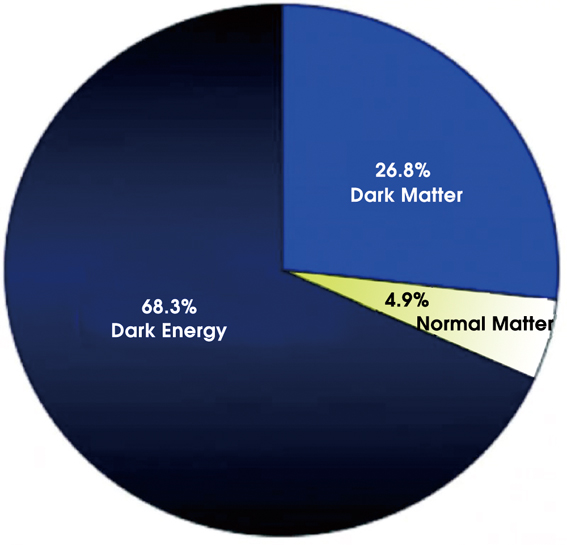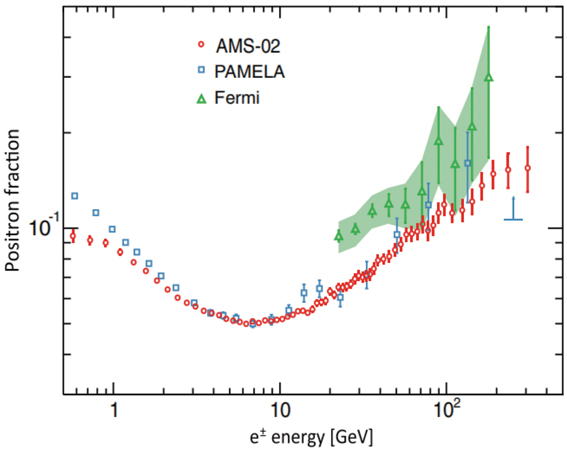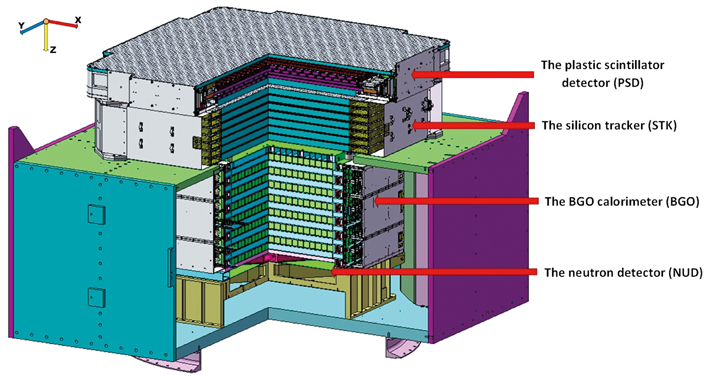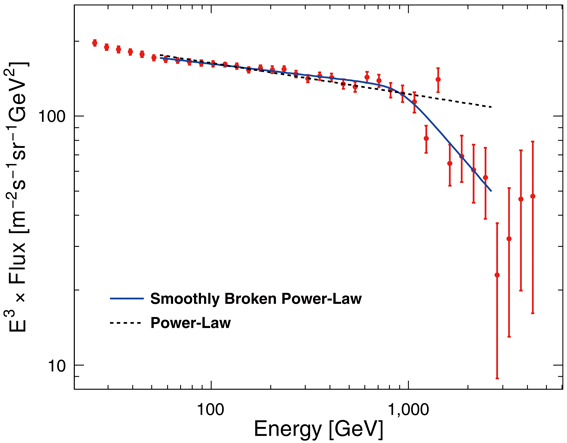By CHANG Jin
Purple Mountain Observatory, CAS
Over the past decades, human beings greatly advanced our understanding of the universe with brilliant accomplishments. Based on the results of recent astronomical observations, a standard cosmological model combining dark matter, dark energy and cosmic inflation has been established. Figure 1 shows the composition of our universe: only 5% of the entire universe is made of known elementary particles, about 27% made of dark matter that does not emit lights, and the remaining 68% or so made of dark energy that is similar to vacuum energy. The search for dark matter particles and the exploration of the nature of dark energy are the most important tasks facing physics and astronomy in the 21th century. A particularly important trend is to bridge the micro- and macro-cosmos, with joint efforts in particle physics and cosmology.

Figure 1: Composition of the universe
In the microscopic field, the standard model of elementary particles has been established. As it is stated in this theory, the fundamental particles currently known are three generations of quarks and leptons, and the gauge bosons that mediate the interactions between them. However, it is generally believed that the so-called standard model is only a phenomenological description of more fundamental theories at low energy. Humankind has sought to find out new physics phenomena in the high-energy window using high-energy colliders. Unfortunately, no new particle beyond the standard model has been found yet – all collider data so far can be accurately predicted by the standard model. This model, however, fails to predict the existence of dark matter. The credit for the latter’s discovery has to be given to astronomical observations. This also illustrates why particle physics and astronomical observations should tightly couple with each other nowadays.
Astronomical observations may reveal new phenomena that cannot be found in colliders. The reason is that in the early era of its evolution, the universe went through a period of very high temperatures. At that time, the energy of the particles was even higher than the upper threshold any man-made collider at present (and possibly even in the future) can achieve, reaching an energy range where new physics might work. Therefore, we can assume that the early universe behaved as an ultra-high energy “collider” whose energy was much higher than what humans can reach. This collider might have produced some unknown particles, and left some traces from them. Dark matter might have been produced during such a new physical process and has since survived the Big Bang. A better understanding of dark matter may play a critical role for humankind in comprehending the fundamental structure and basic interactions of matter.
In the field of astronomical observations, since it was firstly proposed in the 1930s, the concept of dark matter has been confirmed by a large number of astronomical experiments. No matter what the observation targets – a galaxy, a cluster of galaxies or the whole universe – people always come to a consistent conclusion that dark matter does exist. However, all of the observed phenomena can be attributed to only one sole source, namely the gravitational effect of dark matter; in this case the nature of dark matter cannot be determined. What is the nature of dark matter? Which kinds of particles is it composed of? Such kinds of problems have been plaguing people for a long time.
If we rely on the gravitational effect alone, it would be inaccessible to probe the nature of dark matter. At present, the experiments to explore properties of dark matter can be roughly classified into two categories: one is called direct detection experiments, in which the high-sensitivity detectors are used to directly detect the signals generated by the collision between dark matter particles and the detectors’ materials; another is called indirect detection experiments, which detect the products of the self-annihilation or decay of dark matter particle. Although we have no idea of the nature of dark matter, we can derive the inverse process from the phenomena we have observed. In other words, if dark matter was really produced in the collision between particles of the early universe amid ultra-high temperatures, and it has indeed followed the subsequent thermal de-coupling in the wake of the cosmic inflation, we can infer that the inverse process, i.e. the course in which dark matter particles annihilated into ordinary matter, would also occur. Moreover, from the density of present dark matter, the probability of the generation and annihilation of dark matter particles in the early universe can be roughly inferred. The annihilation signal produced by dark matter should be superimposed on the ordinary cosmic-ray background. In general, the energy spectrum of dark matter is different from that of the cosmic-ray background, and this will allow high-sensitivity experiments to identify such signals. The most ideal object for indirect detection experiments is the antimatter particles from its annihilation. This is because the annihilation or decay of dark matter usually produces equal numbers of positive and negative particles. In space, celestial bodies, e.g. stars, pulsars, supernova remnants, and black holes in accretion, may accelerate different particles and hence produce a variety of cosmic rays. When a cosmic ray with sufficiently high energy travels in the galaxy, it will collide with the interstellar medium to produce antimatter cosmic rays. But, the flux of such antimatter cosmic rays is significantly lower than that of the corresponding normal-matter cosmic rays. Therefore, it is easier to identify dark matter signals in antimatter cosmic rays. In order to reliably distinguish between matter and anti-matter, we need a magnetic spectrometer. The project of Alpha Magnetic Spectrometer (AMS-02) led by Mr. Samuel Chao Chung Ting is conducting such a research. However, the magnetic spectrometer is technically challenging and costly, whilst the energy range of the detector is also constrained by the magnetic field strength. In cosmic rays, the ratio of negative electrons to positrons is about 5~20 times; if there exists significant anomaly in the positron energy spectrum, the accurate measurement of the total energy spectrum of the cosmic-ray electrons and positrons (CREs) can still identify this matter. Hence, an alternative kind of experiments is to detect dark matter particles by targeting high-energy CREs in the universe, such as China’s DArk Matter Particle Explorer (DAMPE, nicknamed Wukong), and Japan’s CALET.
Due to the presence of a magnetic field, which deflects high-energy charged particles traveling inside, we cannot obtain the spatial distribution of dark matter in the Milky Way by probing charged particles. To get such information, a gamma-ray telescope is required. Dark matter signals as well as its spatial distribution information can be procured by observing gamma-ray spectra and other specific structures. The Fermi gamma-ray observatory is an example for such kind of experiments. Although China’s DAMPE detector can also observe gamma rays, its acceptance is relatively low. However, the energy resolution of DAMPE is 10 times higher than that of the Fermi satellite of the USA, benefiting the search of gamma-ray line spectra.
The international competition for indirect detection of dark matter in space has been intense. Table 1 gives a list of current experiments for this sake. Among the listed experiments, we can see that DAMPE has advantages over other missions concerning some critical parameters, such as energy resolution and acceptance.

So far, indirect detection experiments in space have caught some anomalies which may potentially trace dark matter particles; however, further data accumulation and more accurate measurements to higher energy are needed so as to determine whether these signals come from dark matter or other astrophysical processes. In early gamma-ray observations, the EGRET telescope on the Compton Gamma Ray Observatory found that the observed flux of gamma-ray from the Galactic Centre is about 40% higher than the prediction by the theoretical model at GeV energies. Some people believed that this “excess” might be relevant to dark matter. In 2009, the Fermi satellite showed instead that this “excess” did not exist and the EGRET results might have been caused by instrumental systematics. The positron spectra and positron fractions, which were measured by the 1994 and 2000 HEAT balloon-borne experiments, revealed that there exist unusual positron excesses above 8GeV. Subsequently, the PAMELA satellite experiment carried out the measurements in a wider energy range, and the results showed that the positron fraction above 10GeV is up to an order of magnitude higher than the value calculated by the usual cosmic ray model. The measurements of PAMELA caught wide attention. In April 2013, the AMS-02 experiment published its measurements of cosmic ray positron fraction with energies ranging from 0.5GeV to 350 GeV. The results are illustrated in Figure 2, clearly indicating that the positron fraction is excessive. In theory, the positron excesses can be explained by the dark matter model; on the other hand, however, similar results can also be given by the pulsar model. Therefore, to determine which physical process has produced these positron excesses, measurements to higher energy with higher precision is needed.

Figure 2: Positron excesses observed by a variety of experiments
As for the electron and positron observations, the ATIC project led by Chinese and American scientists, published the observational results of high-energy CREs in 2008. ATIC found that the flux of CREs is nearly three times higher than the value theoretically predicted in the energy range of 300~800 GeV. These excesses can be interpreted as products of the annihilation or decay of dark matter particles. The results of ATIC showed that the observation of CREs is of great scientific importance. Consequently, many detectors, whose original observational target is not CREs, set off their measurements for this sake. In May 2009, Fermi Gamma-ray Space Telescope published its CRE data with half year observations, and found that the CRE spectrum exceeds the model prediction considerably, which may have the same origin with the above-mentioned positron excesses.
About 20 years ago, China began its own space experiments for indirect detection of dark matter particles. In 1998, the Purple Mountain Observatory (PMO), CAS proposed such kind of scientific goals, which were then verified by accelerator experiments in 1999. In December 2011, the proposal of China’s first dark matter detection satellite, Wukong, was approved. On December 17, 2015, Wukong was launched successfully from the Jiuquan Satellite Launch Center (Figure 3). In March 2016, the management of this satellite was handed to PMO, and it formally went into the stage of scientific operation. Till now, this satellite has been orbiting for more than three years, and has collected a large amount of high-quality observational data. The name of “Wukong” implies that we wish to find the “phantom” of dark matter through its “penetrating eyes.” In English, this satellite was named the DArk Matter Particle Explorer, i.e. DAMPE.

Figure 3: Launch of the Wukong satellite from the Jiuquan Satellite Launch Center in western China. (Credit: Xinhua)
The mass of Wukong satellite is 1,850 kg, and its detector mass is 1,415 kg. The satellite operates at a Sun-synchronous orbit at an altitude of 500 km. Its daily data size is about 13G bytes. The designed lifespan of this satellite is three years. According to current test results, all the detectors work perfectly, and hence it is expected that the satellite will actually serve in space much longer than its designed lifespan. Wukong circles around the Earth 15 times and detects 5 million high-energy particles every day. From its launch to the present, this satellite has been operating stably.
The primary goals of the Wukong satellite are to search for dark matter particles, and to study the origin of cosmic rays as well as the gamma ray astronomy. For the dark matter detection, the Wukong satellite mainly searches for three types of characteristic signals. The first is the line-like gamma-ray spectrum, the second the gamma-ray halo, and the third is the anomalous structure of electron spectrum. These three types of signals are characteristic for dark matter, significantly different from those generated by other astrophysical processes, and hence are extremely crucial for studying dark matter.
Due to the complexity of the cosmic ray composition, the fluxes of different particles differ greatly. For example, the fluxes of CREs and gamma rays, which the Wukong satellite aims to observe, are around 1/103 and 1/106 of that of protons, respectively. The most critical function of the Wukong satellite is to distinguish between various high-energy particles, and to accurately measure their physical parameters. For each critical physical parameter, e.g. charge, energy, direction, etc., two independent measurements are designed to be made, so as to guarantee the high reliability of results.
The Wukong satellite is a telescope used for detecting high-energy particles and gamma rays. It consists of four sub-detectors from its top to bottom. On the top is a plastic scintillator detector, followed by a silicon array detector, a BGO calorimeter and a neutron detector. These four sub-detectors work collaboratively, to achieve high-resolution observations of high-energy electrons, gamma rays and cosmic-ray particles. Wukong has a total of 75,916 signal channels, and is the most complicated operating satellite in the sense of electronics launched by China.

Figure 4: Structure of the Wukong satellite: From the top to the bottom, there is a plastic scintillator detector (PSD), followed by a silicon tracker converter (STK), a BGO calorimeter and a neutron detector (NUD). The combination of these four sub-detectors forms a CRE detector and gamma-ray telescope at GeV~TeV with high spatial-resolution, high energy-resolution, high-sensitivity and low background contamination.
The main function of the plastic scintillator detector is to measure the incoming particle charge. There are a multitude of particles in space, such as the charge of gamma rays is 0, the charge of an electron is -1, the charge of a positron is +1, the charge of a proton is +1, and the charge of each element nucleus increases gradually from the hydrogen to the iron. Therefore, by measuring the charge of incoming particles with high precision, we can identify most particles. The principle of charge measurement is that charged particles deposit their energy in the scintillator via ionization, and the energy loss rate is proportional to the square of the particle charge. The charge resolution of the plastic scintillator of Wukong is 0.12 electron charge for protons, and 0.28 for iron. Its charge resolution is comparable to the highest level of all space detectors in the world.
Below the plastic scintillator detector, there is a silicon array detector, whose function is to measure the direction and the charge of the particles. The performance of the silicon array detector can be characterized by the position resolution. The position resolution precision of the silicon array detector on the Wukong satellite is better than 60 micrometers, indicating that the spatial resolution of this detector also reaches the level of the best gamma-ray telescopes in the world.
Below the silicon array detector, there is a BGO calorimeter, which is the key detector of the Wukong satellite, and its mass exceeds 70% of the total mass of all detectors. The main task of the BGO calorimeter is to measure the energy and direction of incoming particles, and identify the type of particles. The energy resolution of BGO calorimeter is better than 1.5% at TeV energies, which is the highest in the world, far exceeding any other space detectors in the world.
The main function of the bottom neutron detector is to identify different particles. We know that the protons and heavy nuclei from the cosmic rays can act on the detector to produce a large number of secondary neutrons, while the number of secondary neutrons generated by electrons and gamma rays is much less. According to this feature, we can use the neutron detector to identify electron, gamma and nucleus.

Figure 5: Energy spectrum of high-energy cosmic-ray electrons and positrons (CREs) based on the observation conducted by the Wukong satellite during its first 530 days in orbit.
During the first 530 days of its operation, the Wukong satellite recorded 2.8 billion high-energy particles, from which we picked out 1.5 million CREs covering an energy range from 25 GeV to 5 TeV. Based on these samples, we have obtained the CRE spectrum with the highest precision, the lowest background, and the best energy resolution in the world (Fig. 5). In comparison with previous space experiments, Wukong successfully extends its measurement of CREs to energies up to 5 TeV, surpassing the 1 TeV of the Alpha Magnetic Spectrometer (AMS-02), and the 2 TeV of the Fermi Gamma-ray Space Telescope, opening up a new window on the universe.
The Wukong satellite has directly observed a spectral break at ~0.9 TeV in the CRE energy spectrum. This spectral break clarifies how the CRE energy spectrum behaves in the energy range of TeV, and provides key data to judge whether the part of CREs below TeV come from the annihilation of dark matter. Additionally, the data from Wukong has tentatively revealed the presence of a fine spectrum structure at 1.4 TeV. This fine structure is very hard to explain with astrophysical processes. Normally, a celestial process produces a relatively smoother electron spectrum, such as the solid line in Fig. 5. Nevertheless, the current data is not sufficient to make a firm conclusion. The Wukong satellite is continuously accumulating data. Hopefully, with more observational data, we are able to finally clarify the physical nature of this phenomenon.
(Translated by ZHANG Ling)
* This is an authorized translation from an article published in the Issue 2, 2018 of Modern Physics, a Chinese-language magazine aimed at promoting science in the public. BCAS thanks the magazine and the author for their kind permission of and help with the translation.

